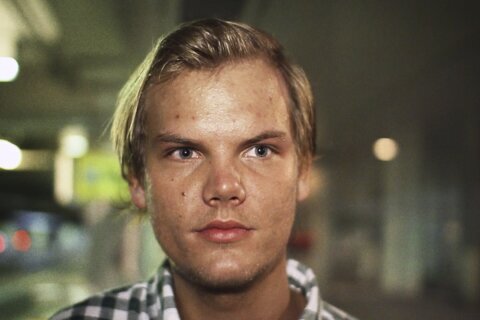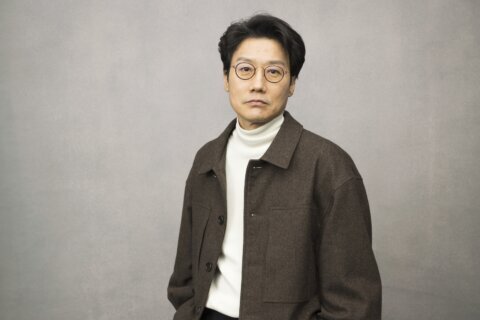WASHINGTON — Gene Roddenberry and Woody Allen both became household names in the fall of 1966, the former with his sci-fi TV hit “Star Trek,” the latter with his directorial debut “What’s Up, Tiger Lily?”
Now, 50 years later in 2016, their faithful followers welcome their newest installments, “Star Trek: Beyond” and “Cafe Society,” in a box office battle of Starship Enterprise vs. Stardust Memories.
Of course, that isn’t a fair fight. Just compare the 1977 receipts for “Star Wars” and “Annie Hall” to predict “Star Trek” as the blockbuster and “Cafe Society” as the Oscar charmer.
These are two films that worship at the alter of different movie gods.
And yet, there’s great news for both sets of fans: both are a ton of fun.
‘Star Trek: Beyond’
There was some understandable nervousness on the part of “Star Trek” fans upon hearing that director J.J. Abrams would be leaving his post after successfully rebooting the series for a new generation with the awesome “Star Trek” (2009) and stellar “Star Trek: Into Darkness” (2013).
There was even more trepidation when Justin Lin was announced as Abrams’ replacement. After all, it was Lin who took over the third installment of the “Fast & Furious” franchise and delivered arguably the most disappointing entry of the entire seven-film series with “Tokyo Drift” (2006).
But fans can breath a sigh of relief: Lin brings it in “Star Trek: Beyond.”
This franchise is still firing on all cylinders in glorious 3D IMAX.
This time, Captain Kirk (Chris Pine), Mr. Spock (Zachary Quinto), Bones (Karl Urban), Scotty (Simon Pegg), Uhura (Zoe Saldana), Sulu (John Cho), Chekov (Anton Yelchin) and the rest of the crew are tested by an evil alien (Idris Elba), who stages an intergalactic ambush on the USS Enterprise.
Co-written by Simon Pegg (“Shaun of the Dead,” “Hot Fuzz”) and Doug Jung (TNT’s “Dark Blue”), the script really champions the camaraderie of the crew — both in hilarious and touching ways.
The side-splitting humor comes in the banter between all the favorite faces we’ve grown to love, each with a distinguishable character trait. It’s impossible not to love Chris Pine’s sarcasm as Kirk, caressing his captain’s chair and fending off foreign creatures in a surprisingly hilarious opening.
We also get Zachary Quinto’s Spock taking every idiom literally; Simon Pegg’s Scotty beaming up his buddies at inopportune times; Bones saying his trademark “damn it” every chance he gets; and the new war-painted face of Sofia Boutella, butchering her colleagues’ names in broken English.
But beyond all the banter, we feel a genuine brotherhood between the Starfleet colleagues. The film will tug at your heartstrings as a restless Kirk contemplates his daddy issues, while a wounded Spock debates leaving the fleet to return to the planet Vulcan, shaken by the passing of his wise Spock elder.
Such anguish feels entirely authentic because of the real-life passing of Leonard Nimoy, who died of pulmonary disease last year at age 83. Even more tragic is the passing of Anton Yelchin, who died last month of a tragic accident at age 27. But unlike the posthumous Paul Walker in “Furious 7,” Yelchin had finished filming at the time of his death. “Star Trek: Beyond” is dedicated to Nimoy and Yelchin.
Adding to the off-screen seriousness is a political debate over Sulu’s sexual orientation. Trekkies have gone back and forth over Sulu’s portrayal as a gay man. Producers argue they’re keeping with the times, since the role’s originator George Takei is gay in real life. However, Takei recently opposed the idea of changing the role. No matter, there’s one shot of Sulu putting his arm around his partner. Deal with it.
Far more worthy of your concern is the ferocious villain Krall, a nasty dude who will suck the life out of other living beings in order to maintain his power. Like Oscar Isaac in “X-Men: Apocalypse” (2016), you won’t recognize Elba under his mountain of prosthetics for much of the movie, but this is quickly becoming the year of Elba villains with “Beasts of No Nation,” “Jungle Book” and “Star Trek.”
As a floating mirror shard catches Elba’s reflection in the final action sequence, we realize Lin’s flair for visual parallels, having shown Kirk’s reflection earlier in the glass of an Enterprise escape pod. The visual motif makes perfect sense: this movie’s themes are all about characters reflecting on their past.
The funniest echo of the past comes as Lin introduces ’90s hip-hop as classical music, pondering a future date where Public Enemy and The Beastie Boys are the Mozart and Beethoven of their times.
As the Beasties’ “Sabotage” erupts with its famous “wahhhhhh” to the fire of a space explosion, we think the movie is about to end, only for the film to continue with a series of false finishes. If there’s one flaw in “Star Trek: Beyond” it’s the inability to leave the party early, but we go with it because the film has built up such good will up until that point. We’re also giddily awaiting the end credits with its nostalgic reading of the old TV quote (“Space, the final frontier”) and the legendary old-school theme.
In this way, past and present collide in a way that is natural and nostalgic without being overkill, namely a shot early on where Spock holds a photo of the late Nimoy and stares out into space. Seeing as this is the first film since Nimoy’s passing, it’s as if the entire series is soul searching in this moment and asking itself, “What now?” By the end, Spock’s character — and the franchise — finds itself with a moment of clarity that comes in the realization that you’re never alone if you have great friends.

‘Cafe Society’
If your comedic tastes are less of the boom-boom banter variety and more in the comedy-of-manners realm, you’ll definitely want to check out Woody Allen’s latest star-studded effort “Cafe Society.”
Throughout his 50 years of filmmaking, there have been many masterpieces, a few stinkers and a string of placeholders. “Cafe Society” falls in the upper-middle echelon, meaning it’s not quite the peak of Woody’s proven potential, but it’s still far better than most other filmmakers’ best efforts.
Set in the 1930s, an aspiring screenwriter named Bobby (Jesse Eisenberg) moves from his quaint Jewish home in the Bronx to chase his dreams in Los Angeles. He hits up his Hollywood big shot uncle Phil Stern (Steve Carell), who brags about Ginger Rogers and Joel McCrea but is hesitant to give him a job. But when Bobby falls for Phil’s jaded secretary Vonnie (Kristen Stewart), his naivety blinds him to the other men in Vonnie’s life.
As a love triangle unfolds in Los Angeles, Bobby begins to debate whether Hollywood is all it’s cracked up to be. Returning to Manhattan, he crosses paths with a recently divorced New Yorker named Veronica (Blake Lively), sparking yet another romance at the nightclub Cafe Society.
Personal life aside, it’s literally unbelievable — and historically unrivaled — what this man has been able to accomplish since his directorial debut in 1966. Few directors write their own screenplays, yet there is Woody Allen, still sitting at his typewriter after all these years, cranking out roughly a script a year for 50 years. That bears repeating. Cranking out roughly a script a year for 50 years. Unbelievable.
He’s so prolific that his own work must be divided into different eras. There’s the early comedy phase of “Take the Money and Run” (1969), “Bananas” (1971), “Everything You Always Wanted to Know About Sex — But Were Afraid to Ask” (1972), “Sleeper” (1973) and “Love and Death” (1975). This is the accessible, lowbrow phase, as the aliens say, “We love your work, especially the early funny ones.”
There’s his masterpiece phase from 1977-1989, when Woody wowed critics and bagged Oscars for “Annie Hall” (1977), “Manhattan” (1979), “Stardust Memories” (1980), “Purple Rose of Cairo” (1985), “Hannah and Her Sisters” (1986), “Radio Days” (1987) and “Crimes and Misdemeanors” (1989).
Then there’s the turn-of-the-century phase of modern-day gems that captured a new generation, films like “Bullets Over Broadway” (1994), “Deconstructing Harry” (1997), “Match Point” (2005), “Vicky Christina Barcelona” (2007), “Midnight in Paris” (2011) and “Blue Jasmine” (2014).
“Cafe Society” offers another chapter in that legacy. It marks the director’s first production by Amazon Studios, which is eager to land Woody for another collaboration with Kate Winslet and Justin Timberlake attached. As “Cafe Society” opens reading “Amazon Studios,” it’s an ironic sign of the times to see Woody’s classic black-and-white opening credits promoting a web film company.
The digital look is striking from the opening shot of a swanky Hollywood pool party, creating a unique juxtaposition of past-and-present as Woody himself narrates with the too-perfect dialogue of Hollywood’s Golden Age. You half expect to find William Holden floating face-first in the pool.
To these eyes, “Cafe Society” is a far more satisfying and coherent send-up of Old Hollywood than this year’s scattershot Coen Brothers effort “Hail Caesar,” which had some hilarious vignettes to be sure (“Would that it were so simple”) without much connecting tissue of the story in between.
The parallel action of lavishly fake Hollywood and gritty in-your-face New York creates for some hilarious moments, particularly as Bobby’s Jewish parents debate the merits of the afterlife. There is also a riotous running joke recalling “Bullets Over Broadway,” as Bobby’s gangster brother (Corey Stoll) whacks anyone who gets in his family’s way and comically dumps their bodies into cement.
While most critics acknowledge Woody’s comedic timing, he remains underrated for his directorial prowess. Academics who analyze mise-en-scene will enjoy his symbolic background images here.
After one of the gangster scenes, we cut to a shot of Eisenberg in phone booth with the background showing a spinning globe that recalls the “World is Yours” globe in “Scarface” (Paul Muni is also referenced minutes earlier). Later, in a budding romance scene where Eisenberg and Stewart visit various celebrity estates, Woody shows a heart-shaped gate pattern positioned between them.
Best of all, their repeated trips to a Mexican restaurant show a giant painting behind them that looks like the Spanish mission from “Vertigo” (1985). Is this an intentional choice to showcase their fatalistic relationship? After all, Eisenberg does try to remake an old love (Vonnie) into a new love (Veronica), not unlike Judy and Madeline. Perhaps this is a coincidence, but it’s nonetheless there.
But more than these subtle symbolic touches, Woody’s films thrive off their casting. Here, Stewart is surprisingly good in a “love to hate her” kind of way; Lively is undeniably beautiful and utterly sympathetic in her innocence; and Carell once again proves he can ditch the funny to play a slime ball.
Still, the real show stealer is Eisenberg, who delivers his best performance of the year, far better than his over-the-top Lex Luthor in “Batman v Superman” or his manic magician in “Now You See Me 2.” Under Woody’s direction, Eisenberg becomes the embodiment of the younger Allen himself, pacing around rooms and neurotically pondering his relationships and his place in the universe.
The entire thing is a delight to watch with a unique blend of belly laughs and bittersweet matters of the heart. It’s amusing from start to finish before giving way to a rather lackluster, unearned, abrupt finish. The abrupt ending somehow isn’t as satisfying as the melancholy at the end of, say, “Annie Hall,” when we learned that we all just needed the eggs. But if you think of it thematically, it makes sense.
There’s a scene early on where Eisenberg writes his aunt a letter from Hollywood to New York. As the aunt writes a return letter describing the falling rain on her Bronx porch, Woody uses her words to tell us the movie’s theme: “It’s pretty, a little melancholy, but that’s life.”









